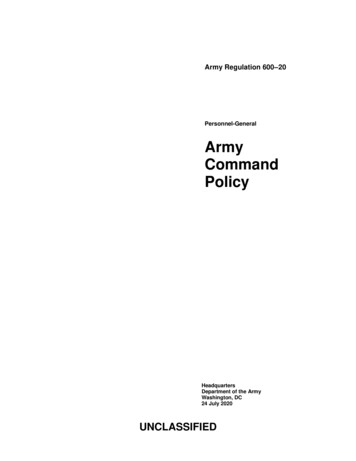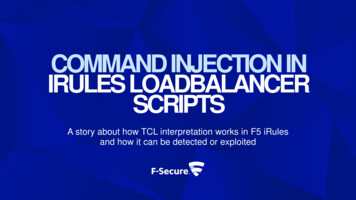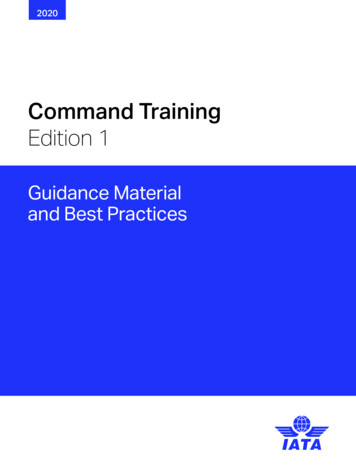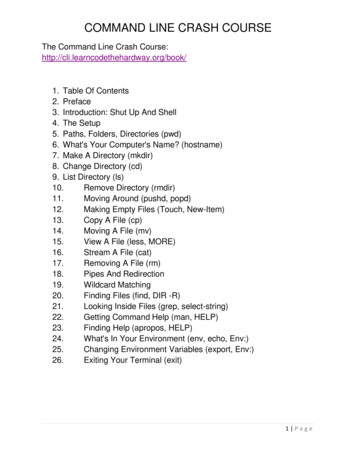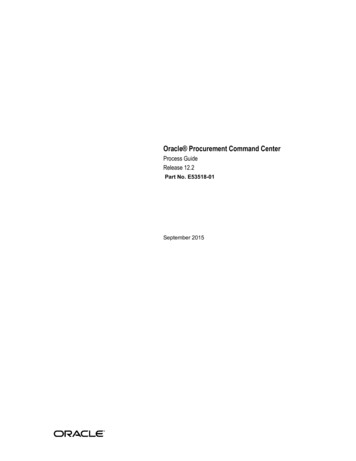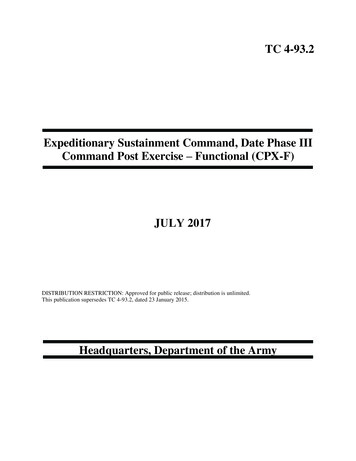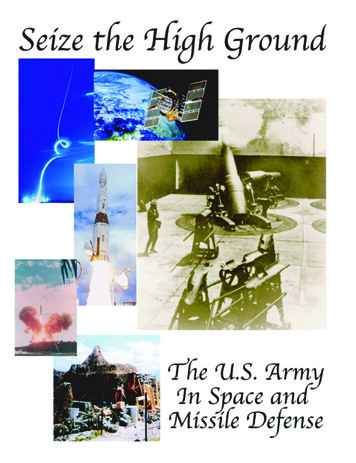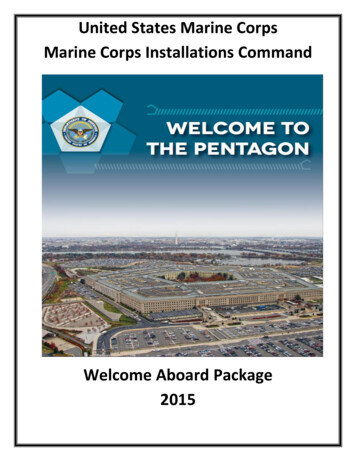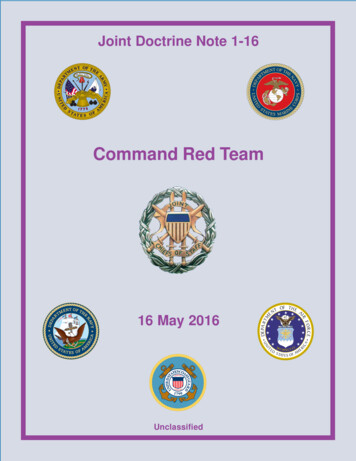
Transcription
Joint Doctrine Note 1-16Command Red Team16 May 2016Unclassified
PREFACE1. ScopeThis joint doctrine note (JDN) provides guidance for the employment of a commandred team on joint planning, analysis, and decision making, and on how to optimize theintegration of red teams into joint functions and operations.2. PurposeA JDN is intended to facilitate information-sharing on problems and potentialsolutions as a supporting effort of formal joint doctrine development and revision. Itadds value to current joint doctrine that aims to improve the efficiency and effectivenessof the joint force. The Joint Doctrine Development Community authorized thedevelopment of a JDN about red teams at the June 2015 Joint Doctrine PlanningConference. This JDN endeavors to supplement current joint doctrine and providecontext for the employment of red teams during the joint planning process and in supportof activities across the range of military operations. This document was developed usingcurrent joint doctrine, extant procedures, and other red team guidance and publications(e.g., The 9/11 Commission Report, University of Foreign Military and Cultural StudiesApplied Critical Thinking Handbook). This JDN does not necessarily describe a positionof consensus across the joint force, but it does present red team related information andprocedures in a non-authoritative document that commanders and staffs can use, asappropriate.3. ApplicationThe guidance in this JDN is not authoritative. If conflicts arise between the contentsof this JDN and the contents of a joint publication (JP), the JP will take precedence forthe activities of joint forces, unless the Chairman of the Joint Chiefs of Staff providesmore current and specific guidance.THOMAS D. WALDHAUSERLieutenant General, USMCDirector, Joint Force Developmenti
PrefaceIntentionally BlankiiJDN 1-16
TABLE OF CONTENTSEXECUTIVE SUMMARY .vCHAPTER IINTRODUCTION TO THE COMMAND RED TEAM Background . I-1The Command Red Team Overview . I-1The Command Red Team and Complementary Analytical Efforts . I-7CHAPTER IICOMMAND RED TEAM ORGANIZATION Overview .II-1Organizational Models .II-1Command Red Team Integration .II-6Command Red Team Membership Considerations .II-7Command Red Team Leader .II-7Command Red Team Education and Training.II-8CHAPTER IIIRED TEAM CHALLENGES Overview . III-1Two Environments . III-1Individual Factors . III-2Organizational Factors . III-6Multinational Considerations . III-10CHAPTER IVRED TEAM ACTIVITIES Overview . IV-1Decision Support . IV-2Critical Review . IV-5Adversary Emulation . IV-10Vulnerability Testing . IV-11CHAPTER VTHE RED TEAM AND JOINT PLANNING Overview . V-1Joint Operation Planning. V-2Operational Art . V-3iii
Table of Contents Operational Design . V-4Joint Operational Planning Activities, Functions, and Products. V-4Joint Planning During Execution . V-8CHAPTER VITHE RED TEAM AND JOINT INTELLIGENCE Overview . VI-1Distinctions between Red Team and Intelligence Functions . VI-1Red Team Contributions to Intelligence . VI-2Support to Intelligence Production . VI-3Red Team Support to Intelligence Planning . VI-5APPENDIXABCCommon Logical Fallacies . A-1Devil’s Advocacy .B-1References .C-1GLOSSARYPART I Abbreviations and Acronyms . GL-1PART II Terms and Definitions . GL-3FIGUREII-1 Standing Red Team .II-4II-2 Matrixed Red Team .II-5III-1 Characteristics of Groupthink . III-7ivJDN 1-16
EXECUTIVE SUMMARYCOMMANDER’S OVERVIEW Provides an Introduction to Command Red Team Explains Command Red Team Organization Describes Red Team Challenges Addresses Red Team Activities Covers the Red Team’s Role in Joint Planning Discusses the Relationship between Red Team and Joint IntelligenceIntroduction to Command Red TeamThe command red team is adecision support element thatprovides an independentcapability to fully explorealternatives in plans, operations,and intelligence analysis.Command red teams help commanders and staffsthink critically and creatively; challengeassumptions; mitigate groupthink; reduce risks byserving as a check against complacency andsurprise; and increase opportunities by helping thestaff see situations, problems, and potentialsolutions from alternative perspectives.The Command Red Team andComplementary AnalyticalEffortsThe distinguishing feature of a command red teamfrom alternative analysis produced by subjectmatter experts within the intelligence directorateof a joint staff is its relative independence, whichisolates it from the organizational influences thatcan unintentionally shape intelligence analysis,such as the human tendency for analysts tomaintain amicable relations with colleagues andsupervisors, and the potential for regularcoordination processes to normalize divergentassessments.Commanders can seek theperspectives of trusted advisors regarding anyissue of concern. A command red team may alsoaddress similar issues, but unlike mostcommander’s advisory/action groups, it supportsthe commander’s staff throughout the design,planning, execution, and assessment ofoperations, and during routine problem-solvinginitiatives throughout the headquarters. Redteams and tiger teams may be ad hoc and addressv
Executive Summarya variety of issues. In many cases, the onlydifference between the two may be theparticipation of a red team member who canadvise the group in the use of structuredtechniques. Alternate modes employ red teamingas a temporary or additional duty or as an ad hocoperation, with teams assembled as needed toaddress specific issues.Command Red Team OrganizationOrganizational ModelsCommand red teams may employ structured or adhoc organizational models. Structured read teamsinclude standing red teams, cadre red teams, andmatrixed red teams.Command Red Team IntegrationAlthough red teams need to maintain a degree ofintellectual and organizational independence, theymust also be integrated into the staff’s regularprocesses. To facilitate operations, teams shouldbe identified as a distinct entity on organizationalcharts, telephone listings, and command websites.In addition, the team should be included as a coremember of those planning teams that address thecommand’s most pressing problem sets.Red teams cannot succeedwithout command support.Command support enables theteam to challenge convention andthe staff to appropriately weighthe team’s inputs.Command Red Team Educationand TrainingThe educational preparation of red team membersassumes the process of stimulating or facilitatingcritical and creative thought is a distinct skill thatcan be taught.Red Team ChallengesTwo EnvironmentsThe red team not only needs to understand theproblem the staff is considering, but it also needsto understand two environments: the individual’scognitive environment and the organizationalculture of the staff. Understanding these twoenvironments is a necessary prerequisite to the redteam’s task of stimulating critical and creativethought and countering the influence oforganizational constraints that might sway,constrain, or prejudice the staff’s thinking.Individual FactorsHelping counter the effects of individualanalytical error is a core red team function.Generally, individuals with a significantviJDN 1-16
Executive Summaryinvestment in a specific point of view will havetrouble reassessing their assumptions andadopting new paradigms. Accordingly, the redteam should strive to use its outside vantage pointto see issues that might escape others. Inaddition, the red team can focus on helpingindividuals consider the possibility that theirexpertise on a problem set might cause them todiscount or misinterpret new information. Someindividual factors include logical fallacies,confirmation bias, status quo bias, fighting theplan, paradox of experience, mirror imaging,ethnocentrism, policy bias, information overload,oversimplification and tunnel vision, hiddenassumptions, assuming away the problem,overconfidence or over-pessimism, failure tomake the call, and elegance vice insight.Organizational FactorsCohesive teams may unconsciously stifle dissentand subtly discourage alternative thinking.Helping counter the effects of these institutionalinfluences, while simultaneously presentingalternative perspectives, requires a cautious,balanced approach by the red team. Commonforms of institutional bias and influence includegroup think, tribal think, no think, boss think,silent think, false consensus, death bycoordination, institutional inertia, hubris, andconflict of interest.Multinational ConsiderationsSome of the organizations that employ red teamsmay have multinational components, either as anintegrated or parallel command structure, or in theform of national liaison officers. Such red teaminteractions with foreign officers have manyadvantages, but like all interactions with foreignofficers, they can also pose unique cultural issuesand potential security challenges.Red Team ActivitiesRed teams are general purposedecision support assets that canenhance problem-solving effortsin all functional areas, in allorganizations, and at allechelons.Red teams employ a variety of tools to frameproblems, challenge assumptions, analyzeconditions, explore solutions, and supportdecision making. While red teams can supportdecision making in all functional areas, they canbe especially useful in those areas where complexvii
Executive Summaryvariables must be considered, where precedentsmay not be applicable, and where the selectedcourse of action (COA) is likely to impactmultiple aspects of the situation.Decision SupportDecision support may consist of providingobservations to key individuals at pivotalmoments, participating in group discussions andbrainstorming sessions, or delivering formalpresentations or written products. Some red teamtechniques for decision support include devil’sadvocacy, problem framing, quality ofinformation check, stakeholder mapping, culturalexpertise, accounting for chaos, and liberatingstructures.Critical ReviewRed teams can also conduct independent criticalreviews of concepts, organizational designs,wargames and exercises, experiments, andprocesses to identify potential weaknesses andvulnerabilities. A critical review may focus onthe information that was used to support adecision (the “input”), the thinking used tounderstand and act on the information (the“process”), or the resulting decision or COA (the“output”).Adversary EmulationAdversary emulation involves simulating thebehavioral responses of an adversary, actor, orstakeholder during an exercise, wargaming event,or an analytical effort, thus helping the staffunderstand the unique perceptions and mindset ofthe actor, and helping the staff understand theactor’s potential range of actions and likelysubjective responses to specific stimuli orsituations. The primary red team role is to reducerisk by helping the staff understand how the otheractor might perceive and respond to friendlyactions.Vulnerability TestingThe red team can be used to help identify physicaland nonphysical weaknesses of physical systems,proposed operational concepts or new weaponsystems, or tactics, procedures, and policies.Vulnerability testing helps identify threats, risks,and vulnerabilities, and explores how systemsviiiJDN 1-16
Executive Summaryfail, how they can adapt to change, and how riskscan be mitigated.The Red Team and Joint PlanningSupport to joint operationplanning is a core red teamfunction.Organizations that plan and execute operationsshould employ red teams to help them thinkcritically and creatively, and see planning oint Operation PlanningRed team Adaptive Planning and Execution(APEX) responsibilities include supporting thedevelopment of their command’s strategicestimates, strategy, theater/functional campaignplans, contingency plans, and APEX orders. Redteams support these activities by seeking unseenopportunities and threats, which may generatenew planning requirements, and by providingalternative assessments of the environment andsituation, which can alert commanders to evolvingthreats or operational conditions that mightgenerate phase change requirements.Operational ArtRed team decision support processes should beemployed to help commanders and their staffsevaluate ends, ways, means, and risks fromdifferent perspectives, thus broadening the rangeof options that may be considered. The red teamshould also suggest potential intended andunintended consequences and likely second andthird order effects related to the ends and waysunder consideration.Operational DesignOperational design promotes the development ofinnovative, adaptive solutions to complexproblems.Ideally, before detailed planningproceeds, the red team should be engaged earlyduring these assessments to help frame theproblem, ensure all relevant features of theenvironment are considered, identify risks andopportunities, and challenge hidden assumptionsand standing assessments.Joint Operational PlanningActivities, Functions, andProductsThe red team should not produce duplicative orcompeting planning materials, but should insteadseek to incorporate its inputs into the planningix
Executive Summaryteam’s final products. The red team shouldreview key sections of the plan and offerrecommendations while those sections are still inthe draft stage.Joint Planning During Execution Planning continues throughout execution in threevenues, each focused on distinct but overlappingtimeframes: future plans, future operations, andcurrent operations. The red team plays distinctroles in each of these, but should normallyconcentrate its efforts in future plans.The Red Team and Joint IntelligenceDespite similarities, red teamshave different objectives than theintelligence staff and should notbe used as a substitute for soundintelligence analysis.Red teams should be organizationally, physically,and intellectually separate from the intelligencefunction in order to ensure that products are notshaped by the same institutional factors thatinfluence the output of the intelligence analysts.Even when the red team and the intelligence staffexamine the same problem set, their productsshould be reviewed and approved throughdifferent product approval chains.Distinctions between Red Teamand Intelligence FunctionsThe intelligence staff seeks to produceaccurate assessments and estimates backed byreliable multi-source information and es could include the following: Constructively challenging assumptions andassessments. Inviting consideration of a broader range ofinterpretations and conclusions. Suggesting new issues for study or issues thatneed additional study. Identifying hidden assumptions, potentialwildcards, and likely effects. Questioning whether the right problems arebeing considered.Red Team Contributions toIntelligenceRed team contributions to intelligence ary analysis, devil’s tion.xJDN 1-16
Executive SummarySupport to IntelligenceProductionRed teams develop independent assessments of asituation or an adversary’s capabilities to supportintelligence products. These assessments aredeveloped using a variety of techniques thatcounter organizational and analytical factors thatcan lead to surprise.Red Team Support to IntelligencePlanningDuring production of plans-related intelligenceassessments and estimates, the red team shouldindependently assess the adversary’s center ofgravity; critical capabilities, requirements, andvulnerabilities; and most likely and mostdangerous COAs.ConclusionThis joint doctrine note (JDN) provides guidancefor the employment of a command red team onjoint planning, analysis, and decision making, andon how to optimize the integration of red teamsinto joint functions and operations. The guidancein this JDN is not authoritative. If conflicts arisebetween the contents of this JDN and the contentsof a joint publication (JP), the JP will takeprecedence for the activities of joint forces, unlessthe Chairman of the Joint Chiefs of Staff providesmore current and specific guidance.xi
Executive SummaryIntentionally BlankxiiJDN 1-16
CHAPTER IINTRODUCTION TO THE COMMAND RED TEAM1. Backgrounda. After studying factors that contributed to a series of strategic miscalculations andintelligence failures before and after 11 September 2001, Congressionally-directedcommissions (e.g., 1998 Jeremiah Panel, 1998 Rumsfeld Commission, 2004 9/11Commission, and 2005 Weapons of Mass Destruction [WMD] Commission) and otheradvisory boards (e.g., RAND Corporation, Defense Science Board, and Institute forDefense Analysis) urged the adoption of red teams in an effort to reduce risk, avoidsurprise, s
Red teams and tiger teams may be ad hoc and address . Executive Summary vi JDN 1-16 a variety of issues. In many cases, the only . and potential security challenges. Red Team Activities Red teams are general purpose decision support assets that can enhance problem-solving efforts File Size: 603KBPage Count: 89

